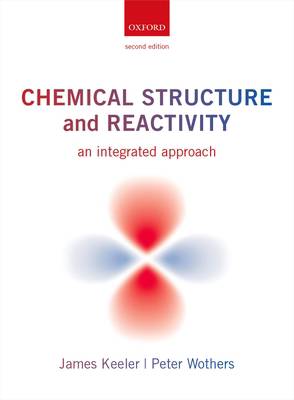
Bedankt voor het vertrouwen het afgelopen jaar! Om jou te bedanken bieden we GRATIS verzending (in België) aan op alles gedurende de hele maand januari.
- Afhalen na 1 uur in een winkel met voorraad
- Gratis thuislevering in België vanaf € 30
- Ruim aanbod met 7 miljoen producten
Bedankt voor het vertrouwen het afgelopen jaar! Om jou te bedanken bieden we GRATIS verzending (in België) aan op alles gedurende de hele maand januari.
- Afhalen na 1 uur in een winkel met voorraad
- Gratis thuislevering in België vanaf € 30
- Ruim aanbod met 7 miljoen producten
Zoeken
Chemical Structure and Reactivity
An Integrated Approach
James Keeler, Peter Wothers
Paperback | Engels
€ 98,95
+ 197 punten
Omschrijving
Why do certain substances react together in the way that they do? What determines the shape of molecules? And how can we predict whether a particular reaction will happen at all? Such questions lie at the heart of chemistry - the science of understanding the composition of substances, their reactions, and properties. Though introductory chemistry is often broken into three sections-inorganic, organic, and physical-the only way for students to fully understand the subject is to see it as a single, unified whole. Chemical Structure and Reactivity rises to the challenge of depicting the reality of chemistry. Offering a fresh approach to the subject by depicting it as a seamless discipline, the text shows how organic, inorganic, and physical concepts can be blended together in order to achieve the common goal of understanding chemical systems. With a lively and engaging writing style enhanced by vivid illustrations, only Chemical Structure and Reactivity makes teaching chemistry with an integrated approach possible. Special Features
--The only introductory text to take a truly integrated approach in explaining the fundamentals of chemistry.
--Fosters an orbital-based understanding of reactions, with clear curly-arrow mechanistic detail throughout.
--A two-part structure allows flexibility of use: Part I lays down the core of the subject, while Part II describes a series of relatively standalone topics, which can be selected to fit a particular course.
--Numerous concepts are illustrated with fully cross-referenced custom-developed online modules, enabling students to develop an understanding through active learning.
--Self-test exercises embedded in the text (with solutions at the end of each chapter) and extensive question sets encourage hands-on learning, to help students master the subject and gain confidence.
--The Online Resource Centre features a range of additional resources for both students and registered adopters of the book. New to this Edition --A new chapter on symmetry has been added to Part I.
--Discussions of organometallic chemistry, spectroscopy, and molecular geometry have been expanded.
--Cross references from Part I to Part II have been increased to make the links between core concepts and more advanced topics clearer.
--More self-test questions and exercises have been provided.
--The only introductory text to take a truly integrated approach in explaining the fundamentals of chemistry.
--Fosters an orbital-based understanding of reactions, with clear curly-arrow mechanistic detail throughout.
--A two-part structure allows flexibility of use: Part I lays down the core of the subject, while Part II describes a series of relatively standalone topics, which can be selected to fit a particular course.
--Numerous concepts are illustrated with fully cross-referenced custom-developed online modules, enabling students to develop an understanding through active learning.
--Self-test exercises embedded in the text (with solutions at the end of each chapter) and extensive question sets encourage hands-on learning, to help students master the subject and gain confidence.
--The Online Resource Centre features a range of additional resources for both students and registered adopters of the book. New to this Edition --A new chapter on symmetry has been added to Part I.
--Discussions of organometallic chemistry, spectroscopy, and molecular geometry have been expanded.
--Cross references from Part I to Part II have been increased to make the links between core concepts and more advanced topics clearer.
--More self-test questions and exercises have been provided.
Specificaties
Betrokkenen
- Auteur(s):
- Uitgeverij:
Inhoud
- Aantal bladzijden:
- 896
- Taal:
- Engels
Eigenschappen
- Productcode (EAN):
- 9780199604135
- Verschijningsdatum:
- 31/12/2013
- Uitvoering:
- Paperback
- Formaat:
- Trade paperback (VS)
- Afmetingen:
- 193 mm x 262 mm
- Gewicht:
- 1859 g

Alleen bij Standaard Boekhandel
+ 197 punten op je klantenkaart van Standaard Boekhandel
Beoordelingen
We publiceren alleen reviews die voldoen aan de voorwaarden voor reviews. Bekijk onze voorwaarden voor reviews.









